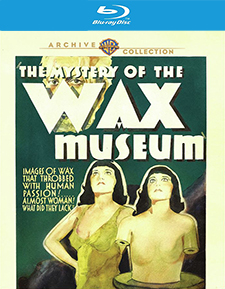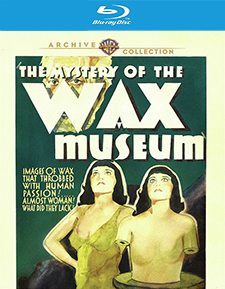Mystery of the Wax Museum, The (Blu-ray Review)

Director
Michael CurtizRelease Date(s)
1933 (May 12, 2020)Studio(s)
Warner Bros. (Warner Archive Collection)- Film/Program Grade: B+
- Video Grade: A
- Audio Grade: B
- Extras Grade: A
Review
The Mystery of the Wax Museum is an early Technicolor horror film directed by Michael Curtiz and starring Lionel Atwill (Son of Frankenstein). Atwill plays sculptor Ivan Igor, who creates lifelike wax figures of historical characters and exhibits them at his London wax museum. A true artist, he is fastidious in every detail. He is also cash-poor and has interested a potential investor in advancing him funds to support the struggling enterprise. But Igor’s partner (Edwin Maxwell), impatient with the museum’s weak drawing power, sets it on fire in an insurance scam to recoup some of his investment.
Igor does his best to stop the conflagration, but to no avail. He is burned terribly in the fire but survives. Twelve years later he re-emerges in New York as the curator of a new wax museum, which features remarkably lifelike figures. Because his hands have become useless due to severe burns, Igor hires and trains another sculptor (Arthur Edmund Carewe) to recreate his figures, using a special technique.
When a fashion model goes missing, reporter Florence Dempsey (Glenda Farrell) follows clues to Igor’s museum, where she discovers a horrifying secret. Florence has a roommate, Charlotte Duncan (Fay Wray), whose boyfriend is one of Igor’s sculptors in training. Catching a glimpse of Charlotte, Igor is struck by how much she resembles his Marie Antoinette figure and becomes obsessed with her.
As its title indicates, the film plays more like a mystery than a traditional horror film, but its underlying theme clearly places it squarely in the horror genre. The first scene shows Igor as a dedicated artist, proud of his wax figures, but not great at the business end of running his establishment. He’s in a world where he loves his companions—the lifelike figures he turns out. He appreciates the compliments paid to his work by the rich investor, and exhibits a touching humility. A far different Igor emerges after the fire destroys the museum and his most valuable asset—his hands. He becomes arrogant and ruthless, determined to recreate his figures at any cost. Obsessed and deranged, he assumes a genial appearance yet harbors horrific plans.
Fay Wray’s Charlotte, the nominal heroine, is a naive and trusting young woman, in marked contrast to the worldly, hardboiled Florence. Even their manner of speaking differs dramatically. Florence, a career reporter in a man’s world, speaks in no-nonsense rat-tat-tat fashion, a trademark of Warner Bros. strong-minded female characters, while Charlotte speaks gently and is slow to realize what’s really going on at the wax museum. Charlotte is the conventional damsel in distress—pretty, vulnerable and in peril. Wray would make a much greater impression in her next film, King Kong.
At times, it seems two different stories are unfolding, the one centered on the wax museum where Charlotte is the object of desire to both her boyfriend and his boss, and the one in the newsroom, where Florence takes action and spars with her boss (Frank McHugh) in a style of dialogue equally suited to The Front Page. In keeping with her character, Farrell projects a self-confident, hip personality, which contrasts with the overall conventional tone of the film, and director Michael Curtiz dilutes the build-up of tension with too-frequent scenes in the newspaper office. The best scenes are the key, creepy ones in the basement of the wax museum. The fire sequence is elaborate, with a lengthy fight between Igor and his partner (courtesy of stunt doubles) as the flames blaze and structural debris comes crashing down. Eerie close-ups of the wax figures melting are intercut as the two men slug it out.
Warner Bros. remade The Mystery of the Wax Museum in 1953 as House of Wax, starring Vincent Price. Shot in 3D, it followed the same story line except that the character of the reporter was removed. It became one of the top ten highest grossing films of the year, eclipsing the original film in popularity.
The Blu-ray of The Mystery of the Wax Museum from Warner Archive features 1080p resolution, and is presented in the aspect ratio of 1.37:1. The film was shot in the early, two-color Technicolor process. It was thought to be lost until a well-worn print was discovered nearly 50 years ago. For this release, the film was restored by the UCLA Film & Television Archive and The Film Foundation. The primary source for the new master was an original 1933 nitrate print owned by Jack L. Warner, with additional pickups from a French work print discovered more recently. When shown on TV years ago, the film looked completely reddish-pink, with little delineation of color tones. This restored Blu-ray version exhibits no visual imperfections and beautifully shows off Ray Renahan’s Technicolor photography. The color palette is dominated by greens and teal in the walls of the wax museum, cars, dresses worn by Wray and Farrell, and silk pajamas worn by Farrell. The most vivid color is a rich, deep green in a dress and matching hat worn by Fay Wray. Flesh tones are creamy, with a rosy blush for the women. Shadows add atmosphere in later scenes inside the wax museum. A huge set is devoted to Igor’s laboratory, with its large tank of boiling wax, long staircase, table filled with chemicals, and a device to apply the hot wax. A hideous “museum monster” with a disfigured face wears a black cloak and hat and moves stealthily.
The English 2.0 mono DTS-High Definition Master Audio soundtrack features crisp, clear dialogue throughout. Farrell speaks very fast, but every word is clear. The fire sequence features good sound mixing of crackling flames, the fistfight between Igor and his partner, and crashing debris. The newspaper office scenes are paced much faster than the museum scenes, with a group of men clacking away at typewriters suggesting the breakneck pace of putting together a newspaper. Fay Wray screams several times and her shrieks are ear-piercing. The tank of bubbling hot wax foreshadows a terrible fate. The sounds of a thunderstorm add atmospheric chills, a horror film cliché that is used to this day. Subtitles in English SDH are available as well.
Bonus materials include two audio commentaries, the documentary Remembering Fay Wray, and a restoration featurette.
Audio Commentary with Scott McQueen – Head of preservation at the UCLA Film & Television Archive, McQueen discusses the sets and sound stages on which the film was shot. In an actual fire at Madame Tussaud’s in London, 300 wax figures were destroyed. For the British release of the film, “London, 1921” was removed from the print. The two-color Technicolor process was a compromise. Technicolor supervisor Natalie Kalmus made specific demands that often conflicted with director Michael Curtiz’s vision. Kalmus said that the color white was forbidden, and Curtiz’s determination to film the movie his way led to an expanded use of Technicolor. Three cameras and 27 setups were needed for the museum fire, with stunt doubles filling in for Lionel Atwill and Edwin Maxwell. Details of filming and special requirements for lighting are detailed. Career overviews are provided for cast members. The wax figures required make-up to stand up under intense light. The Mystery of the Wax Museum was the last feature shot in the two-color Technicolor process at Warner Bros. During its original release, it was shown widely in color throughout the United States. Excerpts from movie reviews of the period are read.
Audio Commentary with Alan K. Rode – The author of Michael Curtiz: A Life in Film notes that Curtiz made 70 films in Europe before coming to Warner Bros. in 1926 to make the Biblical epic Noah’s Ark. He worked through to the early 1960s. The Mystery of the Wax Museum had a 30-day shooting schedule and a budget of $200,000. The wax figures were obtained from a mannequin shop. Because of the intense light required for Technicolor photography, live actors stood in for the wax figures in some scenes. Lionel Atwill was a newcomer to films after a decade-long career on Broadway. The fire sequence was the last scene shot. Curtiz was not particularly concerned with the safety or comfort of his actors. He was demanding in terms of realizing his concept on film. The Warners films of the pre-code era were the sharpest because they often overstepped the bounds and beyond. “Warners had the pulse of the working class.” The initial reviews were mixed. Reference is made to a section of the film in which rolling eyes are “haunted house hijinks” and don’t relate to the rest of the film. “Curtiz used shadows as a visual indication of dread or action.” A scandal involving Lionel Atwill interrupted his career for years and he never regained his former level of success. Curtiz would become one of Warner Bros’ major directors and go on to direct Captain Blood, The Adventures of Robin Hood, Yankee Doodle Dandy, Mildred Pierce, and Casablanca, among others.
Remembering Fay Wray – Victoria Riskin, the daughter of Fay Wray and screenwriter Robert Riskin, discusses her mother’s career. Wray starred in 20 films between 1932 and 1934. The studios were suffering during the Depression, with box office receipts way down. Wray was under contract to Paramount Studios but was often loaned out because she was in demand. She was reliable, attractive, and audiences liked her. Her contract with Paramount expired in 1933 and was not renewed. She became disillusioned by being cast exclusively in horror films and longed for other roles. She eventually appeared in comedies and romantic dramas. She wasn’t as ambitious as other female stars in navigating her career. She felt Michael Curtiz directed The Mystery of the Wax Museum with an iron hand. He was cold, efficient, and not very empathetic toward actors. She was more concerned with how Curtiz treated others than herself. Wray stood in for the Marie Antoinette wax figure because the stage lights would have melted the wax. Riskin believes her mother’s reactions in a few scenes were overblown. Wray never felt King Kong would become so iconic, but eventually embraced and was proud of her connection with the film.
Restoration Featurette – Before and after comparisons are shown for several scenes. In the source material, jump cuts, scrapes, multiple cue marks, red and green dots, and other defects are visible. In the restored version, all imperfections are removed. Dialogue was missing in the Jack Warner print and had to be replaced by footage from the French workprint, which has different color values, so color correction was necessary.
– Dennis Seuling

